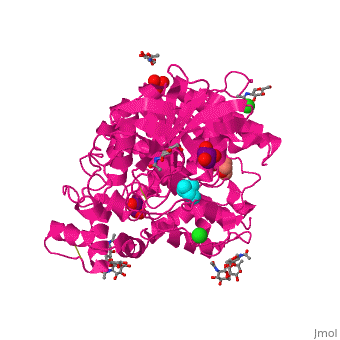Butyrylcholinesterase: Difference between revisions
Michal Harel (talk | contribs) No edit summary |
Michal Harel (talk | contribs) No edit summary |
||
| Line 1: | Line 1: | ||
<StructureSection load='2pm8' size='350' side='right' caption='Human butyrylcholinesterase (PDB code [[2pm8]])' scene='Butyrylcholinesterase/Cv/1'> | <StructureSection load='2pm8' size='350' side='right' caption='Human butyrylcholinesterase (PDB code [[2pm8]])' scene='Butyrylcholinesterase/Cv/1'> | ||
<StructureSection load='1p0m' size='450' side='right' scene= caption='Lymnaea acetylcholine-binding protein pentamer complex with acetylcholine (PDB code 3wip)'> | <StructureSection load='1p0m' size='450' side='right' scene= caption='Lymnaea acetylcholine-binding protein pentamer complex with acetylcholine (PDB code 3wip)'> | ||
[[Image:HuBChE.png|left|300px]] | [[Image:HuBChE.png|left|300px]] | ||
Revision as of 12:05, 15 November 2015
<StructureSection load='1p0m' size='450' side='right' scene= caption='Lymnaea acetylcholine-binding protein pentamer complex with acetylcholine (PDB code 3wip)'> 
FunctionButyrylcholinesterase (BChE) is an enzyme widely distributed throughout the body in humans, but particularly prevalent in serum, where it occurs as a tetramer of catalytic subunits. It is distinguished from the homologous enzyme, acetylcholinesterase, by its ability to hydrolyze the non-natural substrate butyrylcholine as well as the neurotransmitter, acetylcholine. RelevanceBChE finds medical use as a bioscavenger for overcoming organophosphate (OP) nerve agent and insecticide intoxication by interacting rapidly with the toxic agents. DiseaseBChE biological role remains obscure, but mutations in the human BCHE gene result in prolonged post-surgical apnea due to the inability of the mutant BChEs to hydrolyse the local anaesthetic, succinylcholine. |
| ||||||||||
3D structures of BChE3D structures of BChE
Updated on 15-November-2015
Additional ResourcesAdditional Resources
For additional information, see: Alzheimer's Disease
